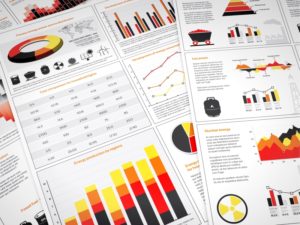The trend of big data has led to the rise of social media platforms handing their consumers  analytics on their presence online. LinkedIn is no different. As a small business, understanding your page’s analytics is vital to its success as it gives you a great amount of information on your target audience’s preferences. But with all analytics, there are some key figures and terms to monitor that give the most insight into your successes and failures.
analytics on their presence online. LinkedIn is no different. As a small business, understanding your page’s analytics is vital to its success as it gives you a great amount of information on your target audience’s preferences. But with all analytics, there are some key figures and terms to monitor that give the most insight into your successes and failures.
Impressions and Engagement Rate
An impression is any time that a post is viewed on a webpage. Impressions are often a mystery to the regular consumer. The major issue is not too many people understand why they rise or fall. It all has to do with the engagement rate. The engagement rate is the
number of interactions (likes, shares, etc…) divided by the number of impressions. A higher engagement rate will lead to more impressions. The idea is that the engagement rate determines the quality of the post. This can be a tad misleading. You want a high engagement rate to reach a larger audience, but you also want to check the actual comments. This is where the quantitative mixes with the qualitative. A high engagement rate may be caused by negative comments. In these cases, you want to pull down your post to avoid that high engagement rate from increasing your reach. Impressions cannot be controlled but should be monitored in conjunction with your engagement rate.
Visitor and Follower Demographics
LinkedIn allows you to see the top demographics of your visitors and followers. Your visitor demographics can alert you to the effectiveness of your promoted content and  advertisements. The visitor demographics will not match up as perfectly as your follower demographics to your target audience, but should be within a short range. Your follower demographics show the effectiveness of your content. These demographics should match up almost perfectly to your target audience. For MyCorporation, our top function follower demographic is entrepreneurship as that is our number one target. If these numbers seem off, the best option is to monitor their fluctuations over time. You may see trends that are contributing to a lack of engagement and will understand how to correct the direction of your content.
advertisements. The visitor demographics will not match up as perfectly as your follower demographics to your target audience, but should be within a short range. Your follower demographics show the effectiveness of your content. These demographics should match up almost perfectly to your target audience. For MyCorporation, our top function follower demographic is entrepreneurship as that is our number one target. If these numbers seem off, the best option is to monitor their fluctuations over time. You may see trends that are contributing to a lack of engagement and will understand how to correct the direction of your content.
Keeping tabs on your LinkedIn analytics is vital to your company page’s success. The right analytics will tell you the trends in your demographics. Understanding why these analytics change over time will allow your marketing team to continually keep a high level of engagement with fans. Although they may seem confusing at first, LinkedIn data analytics are some of your most valuable pieces of market research.
If you are just starting out on LinkedIn, check out LinkedIn Series Part 1: Setting Up Your Small Business Presence.
If you feel like you need more of a base before checking analytics, check out LinkedIn Series Part 2: Attracting a Base Organically.
If you want some advice for navigating the paid advertisements on LinkedIn, check out LinkedIn Series Part 3: Paid Advertising.
Give us a call at 1 (877) 692-6772 or visit us at mycorporation.com, and let us help you start and run your business!